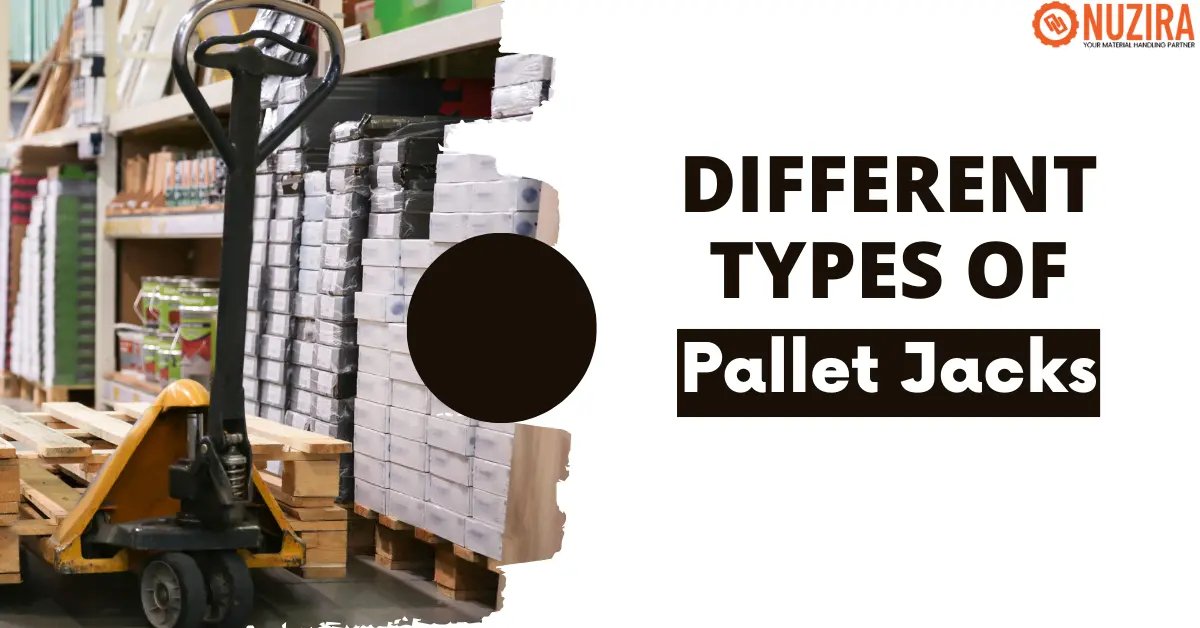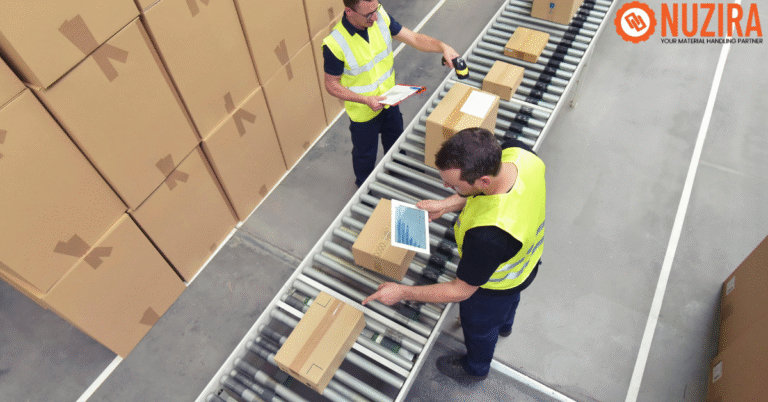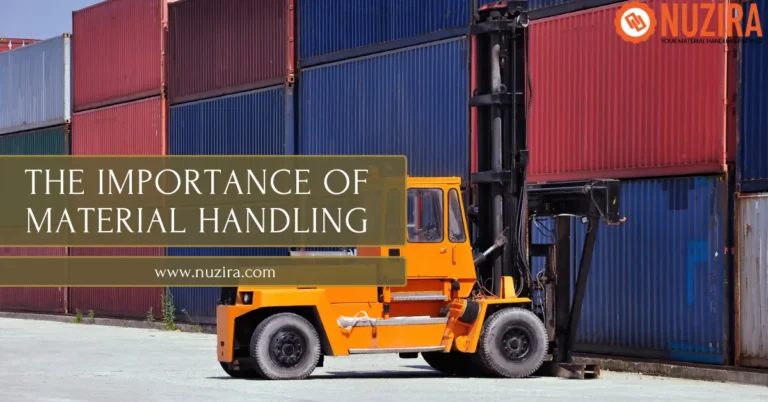Different Types of Pallet Jacks: An Introduction
Pallet jacks are among the most essential tools in warehouses, retail stores, and manufacturing facilities. They provide an efficient and cost-effective way to move heavy loads across short distances.
Unlike forklifts, which handle heavier lifting and stacking, pallet jacks are designed for quick maneuvering and transport at ground level. Before diving into the specific types of pallet jacks, it’s important to understand why they are such a vital piece of material handling equipment.
What Are Pallet Jacks?
A pallet jack. Simple. Sturdy. Essential. Some call it a pallet truck, others a pump truck, but no matter the name, its purpose is the same—moving heavy loads with ease. Two forks slide under a pallet. A hydraulic handle lifts it just a few inches. That’s all. Yet, those few inches change everything. Suddenly, what once felt impossible to move now glides across the floor with little effort. No back strain. No endless dragging. Just smooth, efficient motion.
But don’t mistake simplicity for limitation. Pallet jacks have evolved. Manual. Electric. Semi-electric. Each built for a different job, a different space. The manual jack? Perfect for tight corners and lighter loads. Low cost. Easy to use. The electric jack? Faster, stronger, and a lifesaver in massive warehouses where goods flow nonstop. And then there are the specialists—rugged all-terrain models for outdoor yards, narrow jacks made for cramped aisles where every inch matters.
Here’s the truth: choosing the right pallet jack isn’t optional. It’s critical. The wrong choice slows everything down. Creates bottlenecks. Risks injuries. Costs money. But the right one? It speeds up workflows. Keeps employees safe. Cuts down fatigue. Smooths out logistics. Day after day, week after week. It may look like a humble tool, but the right pallet jack can transform operations—and drive real profitability.
Why Pallet Jacks Matter in Material Handling
Moving goods. Storing them. Shipping them out.
Every operation depends on two things above all: speed and safety.
Forklifts usually steal the spotlight. Big machines. Big power. But the humble pallet jack? It’s the quiet workhorse. Always there. Always reliable.
- Easy to Use: No special license. No long training hours. Just a simple tool that nearly anyone can master in minutes. A forklift demands certification; a pallet jack? Not so much. That’s less downtime, smoother onboarding, and a team that can step in at any moment.
- Cost Savings: Let’s be real—forklifts are expensive. Pallet jacks? A fraction of the cost. Purchase price, upkeep, repairs—all lower. For lighter loads or smaller operations, they’re the obvious choice. Fewer surprises. More savings.
- Space-Friendly: Warehouses are tight. Aisles get narrow. Forklifts struggle. Pallet jacks glide. Their compact size makes them ideal for weaving through crowded layouts, squeezing into corners, and making every square foot count. No wasted space. No traffic jams.
- Less Strain on Workers: Heavy lifting breaks bodies. Overexertion. Injuries. Lost time. Pallet jacks reduce that risk. They shoulder the load, not your staff. By easing strain, they protect health and keep productivity steady day after day.
The Big Question: Pallet Jack or Forklift?
It depends. Both have their role. Forklifts for the heavy, towering lifts. Pallet jacks for everyday mobility, quick moves, tight spaces.
Want to see the differences laid out? Check our guide: Pallet Jack vs Forklift: Understanding the Basics.
Overview of Pallet Jack Types
Not every job looks the same. Neither does every pallet jack. Some are built for smooth warehouse floors. Others? For bumpy construction sites. The right fit depends on where—and how—you work.
- Manual Pallet Jacks: The classic. Simple. Affordable. Reliable. Workers pump the handle, lift the load, and pull it where it needs to go. Perfect for short trips, light loads, and smaller spaces. Think: retail backrooms, small warehouses, businesses with modest shipping needs. When cost and simplicity matter, manual wins.
- Electric Pallet Jacks: Battery-powered. Motor-driven. Fast. Strong. These machines take the strain out of moving heavy loads. Operators glide through long shifts with less effort and more speed. Productivity rises. Fatigue falls. If you’re running a busy warehouse or distribution center, electric jacks make sense. They’re built for volume, safety, and efficiency.
Specialized Options
Not every pallet is the same. That’s why there are special designs:
- Low-profile models slip under thin or uncommon pallets.
- Rough-terrain jacks handle dirt, gravel, and outdoor yards.
- Narrow-aisle versions thrive in tight spaces where every inch counts.
Your pallet jack should match your work. Think about weight. Frequency. Terrain. Efficiency. Choose the one that works as hard as you do.
Manual Pallet Jacks: Simple, Reliable, and Versatile
Manual pallet jacks are the most widely recognized and commonly used type of pallet truck. Known for their simplicity and low cost, they are a staple in warehouses, retail spaces, and small distribution centers. Despite being the “basic” option, manual pallet jacks come in several variations designed to meet specific needs.
Standard Manual Pallet Jacks
The manual pallet jack is a classic. A tool seen everywhere—warehouses, shops, small distribution hubs. One worker. One handle. A quick pump, and the forks rise just enough. Suddenly, a load that seems immovable glides across the floor. No engine. No wires. Just muscle and leverage.
Most models can carry about 5,500 lbs. Some more, some less. Depends on the maker. But the idea is the same: strength packed into a simple frame.
Why They Work So Well:
- Cost-Effective: Cheap to buy, cheaper to keep. Maintenance is almost nothing.
- Easy to Use: No classes. No license. Anyone can learn in a few minutes.
- Compact & Agile: Fits where forklifts choke—narrow aisles, trailers, crowded floors.
Simple doesn’t mean weak. In fact, simplicity is the strength. If the workload is light, the distances short, or the jobs occasional, these jacks are perfect. Sure, they can’t match the speed or stamina of powered models. But for daily, no-fuss tasks? They shine.
Low-Profile Pallet Jacks
Not every pallet is the same. Some sit lower. Much lower. Food industries. Printers. International shipping lines. These sectors often use European or custom pallets that standard jacks can’t touch. The forks just won’t fit.
That’s where the low-profile jack steps in. Its forks ride close to the ground, slipping beneath those tricky pallets without a fight.
Best Uses:
- Specialty Pallets: Slim, odd-sized, or custom builds.
- Mixed Operations: Facilities dealing with both standard and low-clearance pallets.
- Damage Prevention: Less strain, fewer cracks, safer products.
True, the weight capacity might not always equal the standard models. But the trade-off is worth it. Businesses save time. They save pallets. They save money. Instead of switching to costly powered machines—or forcing the wrong tool into the job—operators can simply use this smart, specialized jack.
Efficiency stays high. Loads stay safe. The floor keeps moving.
Wide or Narrow Fork Pallet Jacks
Not all pallets are the same. Standard pallet jacks? They work for most loads, sure. But what happens when the pallet doesn’t fit the mold? That’s where wide and narrow fork options come in.
Think of them not just as “different sizes.” They’re specialized tools. Built to handle what standard forks can’t. And they make work safer, smoother, and quicker.
Wide Fork Pallet Jacks
These are the heavy hitters. Perfect for oversized pallets. Extra-wide crates. Loads with an uneven footprint. A wide jack spreads the weight out, giving stability where a regular jack might wobble. Less tipping. Less stress. More control.
You’ll see them shine in manufacturing plants, construction sites, or warehouses full of custom pallets. Anywhere big, bulky materials roll through the doors—wide forks are the answer.
Narrow Fork Pallet Jacks
Now, flip the script. Small spaces. Tight aisles. Half-pallets. Retail displays. That’s where narrow forks earn their keep.
Their slimmer design squeezes into places wide or standard forks can’t. They glide through trucks. They weave around storage racks. They’re quick, nimble, and efficient in tight quarters.
Bottom line? Match the fork to the load. Wide or narrow, the right fit keeps products secure, workers safe, and equipment lasting longer.
High-Lift Pallet Jacks
Here’s where things get interesting. A high-lift pallet jack isn’t just a jack. It’s a jack and a table. A mover and a workstation.
Instead of lifting only a few inches like a regular jack, these models raise loads up to about 32 inches. Suddenly, a pallet isn’t just sitting on the floor—it’s at working height.
Where They Excel:
- Workstations & assembly lines: Bring materials to a comfortable level. No more constant bending. No more reaching.
- Ergonomics & safety: Less strain. Fewer injuries. Happier backs. Happier workers.
- Packing & fulfillment: Keep boxes right where hands need them. Faster. Smoother. Smarter workflow.
In short: high-lift pallet jacks aren’t only about moving stuff. They transform how people work. They speed up tasks, cut down on fatigue, and boost morale. For any facility serious about safety and productivity, they’re worth every penny.
Rough Terrain Pallet Jacks
Standard pallet jacks? Great indoors. Smooth floors. Controlled spaces. But outside? That’s another story.
Enter the rough terrain pallet jack. Bigger wheels. Pneumatic tires. Steel frames reinforced like armor. These machines are built for punishment. They roll over gravel, dirt, grass—even cracked pavement—without complaint. A regular jack would struggle, but this one keeps moving.
The tires? They absorb shock, so the operator feels less strain. They grip, stabilize, and keep loads steady even when the ground dips or shifts. Heavy pallets. Uneven surfaces. No problem.
Where they shine:
- Construction sites with loose ground or gravel everywhere.
- Garden centers where soil and grass don’t exactly cooperate.
- Loading docks, yards, or outdoor spots where pavement is cracked, sloped, or downright unpredictable.
In short—these pallet jacks break free from warehouse walls. They extend reach into outdoor environments, making tough jobs doable and keeping operations flowing when the ground itself tries to fight back.
When Manual Pallet Jacks Make the Most Sense
Not everything needs power. Sometimes, simplicity wins.
Manual pallet jacks still hold their ground. No fuel. No battery. No charging cables. Just a solid, reliable tool you can grab and go. That’s why businesses keep them around—they’re dependable and cheap to maintain.
They’re best when:
- Loads are moderate, not extreme.
- Budgets are tight, and every dollar counts.
- Travel distances are short—warehouse aisles, small shop floors, quick moves.
- Reliability matters more than high-tech features.
For small and mid-sized businesses, they’re perfect. They bring strength without complexity. Easy to learn, easy to use, easy to fix. No downtime waiting for a charge. No stress about expensive repairs. Just straightforward performance.
By keeping things simple, manual pallet jacks allow teams to focus where it matters—on getting work done.
Electric Pallet Jacks: Power and Efficiency
While manual pallet jacks are reliable and affordable, electric pallet jacks take efficiency to the next level. Also known as powered pallet trucks, these machines use an electric motor to lift and move pallets, reducing physical strain and speeding up operations. For businesses with heavy workloads, larger facilities, or long-distance material movement, electric pallet jacks are a game-changer.
Walkie Pallet Jacks
Walkie pallet jacks are simple, compact, and easy to use. The operator doesn’t ride— they walk behind or beside the machine, steering with a tiller handle. Small design, big convenience. Perfect for aisles that are too narrow for bulky equipment. Handy in spaces with steady but not overwhelming traffic.
They’re one step above manual pallet jacks. Instead of pushing and pulling by muscle alone, you get powered assistance. Less strain. Less sweat. More work done. And still affordable.
Sure, they won’t match the speed of a rider model. But that’s not the point. They offer a sweet balance—efficiency without overspending. Reliable, practical, built for businesses that want goods moving smoothly without the cost of bigger machines.
Best For:
- Warehouses that need maneuverability more than speed.
- Moving heavy loads over medium distances—better than manual, cheaper than advanced.
- Businesses chasing cost, simplicity, and steady productivity in one package.
Rider Pallet Jacks
Rider pallet jacks change the game. No more walking long stretches—operators ride on a platform. That alone saves energy. Less fatigue. Faster work.
These machines shine in large warehouses and busy distribution centers. Places where goods move nonstop. Distance? No problem. Speed? Built in. Fatigue? Reduced dramatically.
Productivity goes up. Morale goes up. Injuries go down. It’s the kind of tool that pays for itself because it keeps workers strong and the workflow fast.
Advantages:
- Boosts productivity in high-volume facilities.
- Cuts fatigue during long shifts, protecting workers and lifting morale.
- Perfect for nonstop operations where speed and efficiency rule.
Counterbalance Pallet Jacks
Some pallets aren’t standard. Some are bulky. Some don’t fit the usual mold. That’s where counterbalance pallet jacks shine.
Instead of relying on bottom boards like traditional pallet jacks, these machines use a counterweight system. The result? They can lift and move irregular, oversized, or custom-built pallets—without breaking a sweat.
The open-front design is a game changer. Operators don’t have to fight with awkward pallet construction. No forcing forks where they don’t belong. No wasted time. Just lift and go.
Another bonus: maneuverability. These jacks weave around bulky loads with ease. That means fewer machines are needed, operations run smoother, and fragile goods are safer. Less struggle. Less damage. More efficiency.
Best For:
- Warehouses with odd-sized or custom pallets
- Operations dealing with bulky, awkward loads
- Businesses needing flexibility without always calling in a forklift
Electric High-Lift Pallet Jacks
Transport. Lift. Repeat. Normally, that takes more than one machine. Electric high-lift pallet jacks change the rules.
They don’t just move pallets. They raise them—right to a comfortable working height. Employees don’t need to bend, strain, or twist. The work gets easier. Safer. More efficient.
Picture a packaging station. An assembly line. A stock room. Workers reaching waist-level pallets without constant bending. That’s the advantage here.
And it’s all powered by electricity. No pumping. No wasted energy. Just smooth, consistent lifts. Plus, they’re compact. Easier to move than forklifts. Perfect for mid-level tasks where speed and mobility matter.
Best For:
- Workstations with frequent loading or assembly
- Jobs that need ergonomic lifting to cut down on injuries
- Operations wanting forklift alternatives for moderate lifting
When to Choose Electric Over Manual
Sometimes a pallet jack isn’t just a pallet jack. Sometimes it’s the difference between a team that’s worn out and one that’s cruising through the day. That’s where electric pallet jacks come in.
- Heavy loads? Every day? Manual jacks will wear people down. Electric ones? They take the strain off shoulders, backs, and knees. Push a button—done.
- Big facilities, long routes. Imagine walking hundreds of feet again and again, pulling a manual jack. It’s slow. It’s tiring. Electric models glide across that same distance in a fraction of the time, and workers don’t burn out before lunch.
- Fast-paced workflows. When speed matters—stocking shelves, loading trucks, moving shipments—manual tools just can’t keep up. Electric pallet jacks keep things moving. Smoothly. Safely. Quickly.
Yes, the price tag is higher. No question. But think of it like this: you’re not just buying equipment, you’re investing in time saved, energy preserved, and injuries prevented. And that ROI? In busy operations, it shows up faster than you’d think.
Conclusion
Understanding the different types of pallet jacks helps businesses choose the right equipment for their needs. Manual pallet jacks remain a cost-effective and versatile choice for smaller operations, offering reliability and simplicity. On the other hand, electric pallet jacks provide the power and efficiency required for larger warehouses and high-demand environments.
By selecting the right type of pallet jack—whether manual, electric, or a specialized model—companies can streamline operations, improve worker safety, and save time on material handling.
If you’re ready to explore pallet jacks or want to learn more about other equipment solutions, visit our website for expert resources and trusted products designed to meet your material handling needs.







